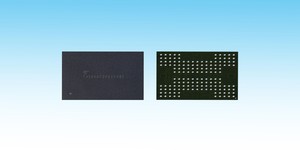Samsung has announced that it has started mass-production of a stacked NAND flash memory chip it has dubbed 3D Vertical NAND, or 3D V-NAND, with a promise of significantly better scaling than traditional planar parts.
Designed for mobile devices, Samsung's 3D V-NAND replaces the traditional flat layout of a semiconductor for a three-dimensional layered approach. Multiple planar memory cells, based on the Charge Trap Flash (CTF) architecture developed by the company in 2006, are stacked on top of one another in a manner which the company claims not only increases capacity while retaining the same footprint but also boost performance and longevity.
According to Samsung's testing, the 3D V-NAND parts boast a minimum twofold increase in reliability over planar 10nm floating-gate NAND flash - peaking at 10x - but also double the write performance. Using a new vertical interconnection process, the company also claims to be able to layer up to 24 cells on top of one another - potentially allowing for up to 384Gb, or 48GB, chips to be created using a 20nm production node and sharing the same footprint as existing 16Gb parts.
'The new 3D V-NAND flash technology is the result of our employees’ years of efforts to push beyond conventional ways of thinking and pursue much more innovative approaches in overcoming limitations in the design of memory semiconductor technology,' crowed Jeong-Hyuk Choi, Samsung Electronics' senior vice president for flash products, at the announcement. 'Following the world’s first mass production of 3D Vertical NAND, we will continue to introduce 3D V-NAND products with improved performance and higher density, which will contribute to further growth of the global memory industry.'
Samsung is positioning the technology as an answer to the issues of scaling NAND flash down to ever-smaller process nodes. With flash hitting 10nm today, increasing its performance and density by dropping to still-smaller process sizes becomes increasingly difficult - but stacking offers an alternative to boost components' capabilities without changing process size.
The company's announcement comes as industry watcher TrendForce has announced a quarter-on-quarter increase in NAND flash demand of 11.2 per cent and that prices for high-density 64Gb components more than doubled since the start of the year - clearly indicating a demand. With startup Crossbar promising to make NAND flash obsolete with its 1TB RRAM resistive memory components, Samsung could have a fight on its hands for the future of mobile storage. Samsung starts with a lead, however: the company has already begun mass production of 128Gb 3D V-NAND components.
Designed for mobile devices, Samsung's 3D V-NAND replaces the traditional flat layout of a semiconductor for a three-dimensional layered approach. Multiple planar memory cells, based on the Charge Trap Flash (CTF) architecture developed by the company in 2006, are stacked on top of one another in a manner which the company claims not only increases capacity while retaining the same footprint but also boost performance and longevity.
According to Samsung's testing, the 3D V-NAND parts boast a minimum twofold increase in reliability over planar 10nm floating-gate NAND flash - peaking at 10x - but also double the write performance. Using a new vertical interconnection process, the company also claims to be able to layer up to 24 cells on top of one another - potentially allowing for up to 384Gb, or 48GB, chips to be created using a 20nm production node and sharing the same footprint as existing 16Gb parts.
'The new 3D V-NAND flash technology is the result of our employees’ years of efforts to push beyond conventional ways of thinking and pursue much more innovative approaches in overcoming limitations in the design of memory semiconductor technology,' crowed Jeong-Hyuk Choi, Samsung Electronics' senior vice president for flash products, at the announcement. 'Following the world’s first mass production of 3D Vertical NAND, we will continue to introduce 3D V-NAND products with improved performance and higher density, which will contribute to further growth of the global memory industry.'
Samsung is positioning the technology as an answer to the issues of scaling NAND flash down to ever-smaller process nodes. With flash hitting 10nm today, increasing its performance and density by dropping to still-smaller process sizes becomes increasingly difficult - but stacking offers an alternative to boost components' capabilities without changing process size.
The company's announcement comes as industry watcher TrendForce has announced a quarter-on-quarter increase in NAND flash demand of 11.2 per cent and that prices for high-density 64Gb components more than doubled since the start of the year - clearly indicating a demand. With startup Crossbar promising to make NAND flash obsolete with its 1TB RRAM resistive memory components, Samsung could have a fight on its hands for the future of mobile storage. Samsung starts with a lead, however: the company has already begun mass production of 128Gb 3D V-NAND components.

MSI MPG Velox 100R Chassis Review
October 14 2021 | 15:04









Want to comment? Please log in.